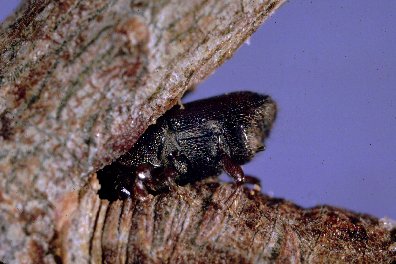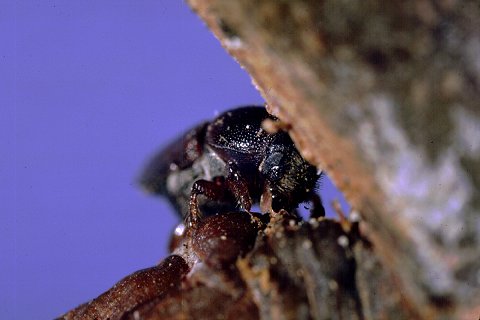Byers, J.A., Svhira, P., and Koehler, C.S. 1980.
Attraction of elm bark beetles to cut limbs on elm. Journal of Arboriculture 6:245-246.  pdf
pdf
 Elm bark beetle, Scolytus multistriatus, boring into twig crotch of elm in order to feed. Spores of Dutch elm disease fungus are
introduced in these wounds. Mating occurs here and then the female makes galleries in the trunk where she lays eggs.
Elm bark beetle, Scolytus multistriatus, boring into twig crotch of elm in order to feed. Spores of Dutch elm disease fungus are
introduced in these wounds. Mating occurs here and then the female makes galleries in the trunk where she lays eggs.
Abstract.
The smaller European elm bark beetle, Scolytus
multistriatus, vector of the Dutch elm disease fungus, is attracted
to pruned limbs of European and Siberian elm compared to
healthy, non-pruned limbs. To minimize the spread of
Dutch elm disease it is suggested that pruning of elm limbs be
undertaken during the fall and winter when bark beetle activity
is reduced or absent.
The smaller European elm bark beetle, Scolytus
multistriatus (Marsh.), the vector of the Dutch elm
disease fungus, Ceratocystis ulmi, releases
chemical attractants (pheromones) when feeding
on elm subcortical tissue resulting in the aggregation
of beetles and subsequent colonization of the
host (4, 9). Before pheromones are released, the
first beetles to arrive at a potential host appear to
use, at least in part, elm odors in locating breeding
sites (7, 8, 10). Evidence presented by Meyer
and Norris (1967a) suggests that S. multistriatus
flies upwind in response to host volatiles released
by American elm logs, Ulmus americana. Their experimental
method must be questioned since the
placements of treatment and control traps were
not randomly assigned or even alternated to correct for possible positional effects. In the
laboratory, Meyer and Norris ( 1967a) reported
that S. multistriatus was attracted to air containing
volatiles from either elm logs or elm bark extractives. We performed a chi-square analysis of their
data and found no significant differences in attraction between host volatiles and control air (in all
comparisons p µ 0.15). In another study, Meyer
and Norris (1967b) showed that beetles were attracted
in the laboratory to certain oxidative products of lignin indicating that S. multistriatus may
utilize compounds in orienting to dying or decaying hardwood trees. Evidence that S. multistriatus
may orient to freshly cut logs was shown by
Svihra and Koehler (1980). They found that
Siberian elm, U. pumila, and English elm, U. procera, logs were more attractive than Chinese elm,
U. parvifolia, logs or a blank. This attraction to cut
elm logs may be caused by the release of larger
quantities of alpha-cubebene, a component of the
beetle's pheromone (4).

Elm bark beetle, Scolytus multistriatus, feeding in twig crotch of elm
Hart et al. (1967) found that the incidence of
Dutch elm disease increased dramatically in areas
where trees were pruned during the growing
season of the previous year. They found in areas
with high populations of S. multistriatus a few of
the recently pruned trees had sustained bark
beetle attack in the lower trunk. The Dutch elm
disease fungus was isolated trom the beetle
galleries and the following summer most of the
trees wilted from the disease.
We wanted to determine if the observed
association of Dutch elm disease with the pruning
of apparently healthy elms could be due to the at-
traction of S. multistriatus to pruning wounds. A
non-parametric statistical analysis of beetle catch
on pairs of sticky traps on pruned and non-pruned
branches of English and Siberian elms was used
to test if S. multistriatus is attracted to recently
pruned branches.
Methods and Materials
Thirty-four pairs of 25 X 25 cm hardware
screen traps (1/4 inch mesh) coated with Stickem
Specialo were placed on 34 elm trees, 17 were
English elm (Pleasanton, CA) and 17 were
Siberian elm (Livermore, CA). The traps were attached vertically to limbs (5±2 cm dia.) about
2±0.5 m above the ground. One trap of each pair
was fixed to the end of a limb that had been sawn
off while the other trap was fixed in a similar way
to an apparently normal branch about 3±0.5 m
away from the pruned branch. The paired traps
were placed on the pruned trees on May 21,
1979 and adults of S. multistriatus and S. rugulosus were collected from the traps after 6
and 20 days and placed in vials containing
hexane. The beetles were counted and identified
in the laboratory. Beetle catches were compared
using the Wilcoxon test (6). Only paired traps
were included in which at least one of the traps
caught beetles.
Results and Discussion
The catch of S. multistriatus on 2 of 11 trap
pairs appeared to have been influenced by
pheromonal attraction since attacks of the beetle
were observed in two pruned branches. On the
remaining 9 trap pairs, a total of 19 S. multistriatus
was caught on traps on the pruned branch while a
total of 5 beetles was caught on traps on the non-pruned branch. Statistical analysis showed that
the traps associated with pruned branches caught
significantly more beetles (p=0.025). Only 2
beetles were caught on traps during the first 6
days (on two prune-branch traps) and these data
were not used in the analysis. It is not known how
much pheromonal attraction influenced the trap
catch on pruned branches except in the two
cases where hundreds of beetles were caught.
However, the non-parametric statistical analysis
that was used minimized the effect of these large
numbers since the paired comparisons were
ranked. Only 9 pairs out of 34 paired traps caught
26 beetles, indicating that the attraction elicited
by pruning wounds is rather weak compared to
pheromonal attraction (where the 2 prune traps
caught several hundred beetles).
The number of shothole borers, S. rugulosus,
caught on prune-branch associated traps was also
higher than on the non-prune-branch traps (25 vs
3) (p=0.017).
The wounding (pruning) of English and Siberian
elm appears to enhance the release of volatile attractants from the host which increases the
response of both S. multistriatus and S. rugulosus. However, the possibility of the beetle's
pheromones enhancing or causing the attraction
cannot be conclusively ruled out. S. multistriatus
that have been attracted and remain to feed on the
elm branch because of feeding stimulants (1, 2)
would release pheromone and attract additional
beetles.
Pruning increases the visitation rate of S. multistriatus and probably increases the chances
of attack and introduction of the Dutch elm
disease fungus. Our results may explain, at least
in part, why Hart et al. (1967) found a higher incidence of Dutch elm disease associated with elm
trees that had been pruned. Thus, pruning should
be undertaken during the late fall and winter when
beetle flight is known to be minimal or absent (3).
Acknowledgments
We would like to thank Dr. David L. Wood, Department of Entomological Sciences,
University of California, Berkeley, for
the use of research facilities and his review of the manuscript.
We also thank Kenneth Q. Lindahl, Jr., Group in Biostatistics,
University of California, Berkeley, for review of the statistical
methods.
Literature Cited
1. Baker, J.E. and D.M. Norris. 1968a. Furtherbiologicaland
chemical aspects of host selection by Scolytus multistriatus. Ann. Entomol. Soc. Amer. 61:1248-1255.
2. Baker, J.E. and D.M. Norris. 1968b. Behavioral responses
of the smaller European elm bark beetle, Scolytus multistriatus, to extracts of non-host tree tissues.
Entomol. Exp. Appl. 11:464-469.
3. Brown, L.R. 1965. Seasonal development ol the smaller
European elm bark beetle in southern California. J. Econ.
Entomol. 58:176-177.
4. Gore, W.E., G.T. Pearce, G.N. Lanier, J.B. Simeone, R.M.
Silverstein, J.W. Peacock, and R.A. Cuthbert.1977. Aggregation attractant of the European elm bark beetle,
Scolytus multistriatus production of individual components and related aggregation behavior. J. Chem.
Ecol. 3:429-446.
5. Hart, J.H., W.E. Waliner, M.R. Caris, and G.K. Dennis.
1967. Increase in Dutch elm disease associated with
summer trimming. Plant Dis. Reptr. 51:476-479.
6. Lehman, E.L. 1975. Nonparametrics: statistical methods
based on ranks. Holden-Day, Inc. 457p.
7. Meyer, H.J. and D.M. Norris. 1967a. Behavioral responses
by Scolytus multistriatus (Coleoptera: Scolytidae) to
host-(Ulmus) and beetle-associated chemotactic stimuli.
Ann. Entomol. Soc. Amer. 60:642-646.
8. Meyer, H.J. and D.M. Norris. 1967b. Vanillin and syringaldehyde
as attractants for Scolytus multistriatus (Coleoptera: Scolytidae). Ann. Entomol. Soc. Amer.
60:858-859.
9. Pearce, G.T., W.E. Gore, R.M. Silverstein, J.W. Peacock,
R.A. Cuthbert, G.N. Lanier, and J.B. Simeone. 1975.
Chemical attractants for the smaller European elm bark
beetle Scolytus multistriatus (Coleoptera: Scolytidae). J.
Chem. Ecol. 1:115-124.
10. Svihra, and C.S. Koehler. 1980. Attraction of the smaller
European elm bark beetle, Scolytus multistriatus to the
elm wood ol different species. Environ. Entomol. (in
press).
Department of Entomological Sciences, and
Cooperative Extension
University of California,
Berkeley, California
 Elm bark beetle, Scolytus multistriatus, boring into twig crotch of elm in order to feed. Spores of Dutch elm disease fungus are
introduced in these wounds. Mating occurs here and then the female makes galleries in the trunk where she lays eggs.
Elm bark beetle, Scolytus multistriatus, boring into twig crotch of elm in order to feed. Spores of Dutch elm disease fungus are
introduced in these wounds. Mating occurs here and then the female makes galleries in the trunk where she lays eggs.
